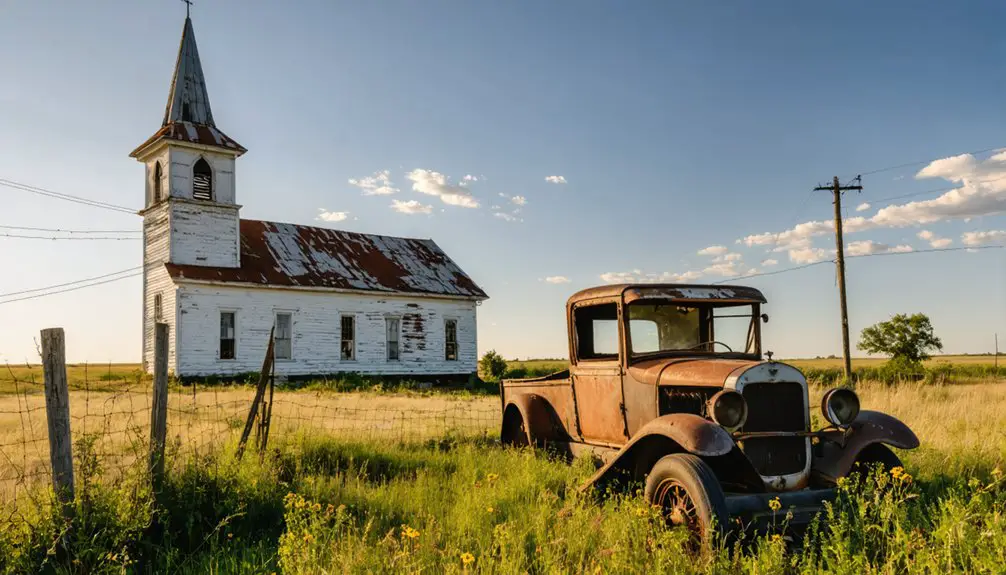You’ll find Port William’s ghostly remnants along a remote bend of the Missouri River, where William Johnson’s frontier fort once protected settlers in the 1850s. The town thrived briefly as a crucial crossing point, charging ten cents for foot passengers and a dollar per wagon. Saturday brawls and bustling ferry docks defined its untamed spirit before decline set in. Today, nature has reclaimed the site, but buried beneath the prairie grasses lie stories of a forgotten Kansas crossing.
Key Takeaways
- Port William was established in the 1850s as a Missouri River crossing point, initially known as Fort Williams built by William Johnson.
- The town thrived through ferry operations and river trade, charging $1 per wagon and serving as a commercial link between Kansas and Missouri.
- Social instability, marked by frequent brawls and unsafe streets, contributed to families and businesses leaving the settlement.
- The closure of the post office by 1860 and local coal mines led to economic decline and increased crime rates.
- Nature has reclaimed the abandoned town site, with dense oak forests and prairie grasses covering old foundations and ferry crossings.
The Birth of a River Settlement
As the Kansas Territory opened for settlement in the mid-1850s, a strategic river crossing emerged at a sweeping bend of the Missouri River, birthing the settlement of Port William.
You’d have found William Johnson’s pioneering cabin there, initially known as Fort Williams, serving as a protective haven for early settlers in this untamed frontier.
The settlement dynamics quickly shifted when Jake Yunt established a hand ferry crossing in 1854, connecting the Missouri side to what would become Port William.
As waves of settlers pushed westward, primitive river crossings gave way to steam-powered vessels, transforming this modest outpost into a bustling transport hub.
The ferry service generated substantial income, with daily earnings reaching $100 during peak operations.
The town was officially incorporated in 1855 by the territorial legislature, marking its formal recognition as a settlement.
Life Along the Missouri Bend
While most river settlements maintained orderly facades, Port William earned a reputation for its untamed spirit and boisterous gatherings. You’d have found farmers from miles around flocking to witness the Saturday afternoon brawls, where local bullies settled their differences with fists rather than words. Much like the diverse trading hub that characterized Bent’s Old Fort, Port William attracted a wide variety of travelers and settlers seeking opportunities. Similar to how Judge Silas Bent had established roots in Missouri, the early settlers of Port William sought to build lasting foundations along the river.
Life along the Missouri Bend wasn’t just about these rough entertainments, though – you’d have seen Jake Yunt’s hand ferry evolving into steam-powered vessels, marking the settlement’s growth amid river navigation challenges.
The Missouri River’s constant flow brought change and commerce, with the ferry service bridging two states and connecting settlers to essential trade routes. Despite the rough exterior, Port William served as a significant lifeline for those seeking opportunities in the expanding frontier.
Frontier Justice and Saturday Brawls
When formal law enforcement remained scarce in Port William, frontier justice filled the void through vigilante groups and organized community responses.
You’d find anti-horse thief associations taking swift action against livestock rustlers, delivering harsh punishments without the formality of trials or juries. Thieves often faced immediate hanging as punishment. The region’s political tensions during Bleeding Kansas only intensified this climate of vigilante justice. Similar to Fort Scott’s experience, both factions organized themselves for protection in the volatile territory.
Port William’s reputation for public violence peaked during its notorious Saturday brawls.
You could join the crowds gathering to watch farmers and locals duke it out in these weekly spectacles. Town bullies frequently sparked these confrontations, which became as much a part of Port William’s character as its position along the Missouri River.
These fights reflected the raw spirit of frontier life, where physical prowess often settled disputes more readily than courtroom proceedings.
From Hand Ferry to Steam Power
The humble origins of Port William’s river crossing began in 1854 with Jake Yunt’s hand ferry, an essential lifeline connecting Missouri’s western shore to the Kansas settlement. You’d pay just ten cents as a foot passenger to cross the mighty Missouri, joining the steady stream of settlers and traders seeking opportunity in the frontier town. Similar to the Atchison Steam Ferry established in 1857, this crossing point served as a vital transportation link for the region.
The ferry evolution marked a significant chapter in Port William’s brief but vibrant history. When mounting traffic demanded faster service, the steam shift revolutionized river crossing capabilities. Steam-powered ferries appeared in the late 1850s and early 1860s through enterprising ferrymen’s efforts.
You’d find steam-powered ferries churning the waters between Sumner, Atchison, and Missouri settlements, moving cargo and passengers with newfound efficiency. This modernization reflected your pioneer ancestors’ determination to tame the wilderness, though it couldn’t prevent Port William’s eventual fade into ghost town status.
The Town’s Brief Golden Age
If you’d visited Port William during its heyday, you’d have witnessed steamboats churning up and down the Missouri River, bringing goods and travelers to this bustling frontier outpost.
The town’s strategic location made it a natural hub for farmers and traders, who’d gather to conduct business and exchange the latest news. Like Columbia, Kansas, the town was fortunate to have a good ford crossing that facilitated travel and commerce. However, like many early Kansas settlements, it faced fierce competition from towns like Atchison and Sumner for regional dominance.
While Port William earned a reputation for its rowdy Saturday entertainment, with crowds gathering to watch fistfights and share drinks, the town’s true economic pulse came from its role in connecting agricultural communities to essential river commerce.
River Commerce Peak
During Port William’s golden age, bustling ferry landings transformed this small riverside settlement into an essential commercial artery connecting Kansas and Missouri.
You’d have witnessed a thriving hub of river trade, where steamboats and ferries carried wagons, freight, and fortune-seekers across the mighty Missouri. The ferry company’s strategic investments in wagon roads and river-control dams helped maintain crucial links to the Platte country and beyond.
At $1 per wagon, the ferry service drove economic expansion while connecting to the “Great Central Route” toward gold rush territories.
You’d have seen Russell, Majors & Waddell’s massive ox-drawn “bull-trains” lumbering through, carrying supplies that sustained the region’s growth.
Despite seasonal challenges and shifting sandbars, Port William’s commercial spirit persevered through innovative river engineering and determined entrepreneurship.
Daily Life and Entertainment
While Missouri River commerce drove Port William’s economy, a rough-and-tumble social scene defined its character.
If you’d visited on a Saturday, you’d have found local farmers gathering to watch fistfights and brawls unfold near the ferry landing. These weekend spectacles became a regular form of entertainment in a town where daily routines revolved around river trade and transportation.
Your social gatherings would’ve centered around the bustling ferry dock, where travelers, settlers, and traders mixed freely.
You might’ve found yourself in one of the town’s saloons or gambling houses, participating in the frontier revelry that made Port William notorious. Without formal law enforcement, the town bullies held sway, and the nightlife remained wild and untamed – a reflection of the unbridled spirit of Kansas river settlements.
Forces Behind the Decline
You’ll find the roots of Port William’s decline in its growing isolation, as major transportation routes gradually shifted away from the once-bustling river town.
The absence of reliable connections to larger markets took its toll on local businesses and trade, while mounting social tensions created an increasingly unstable environment for residents and merchants alike.
These forces worked in tandem to accelerate Port William’s downward spiral, as families and businesses sought more promising opportunities in better-connected and safer communities.
Transportation Routes Shifted Away
As steamboats began replacing traditional ferry crossings in the mid-1800s, Port Williams’ strategic importance as a Missouri River crossing point steadily diminished.
You’d have seen the transportation evolution unfold as Jake Yunt’s once-bustling ferry service gave way to larger steam-powered vessels that could handle increased settler movement more efficiently.
The economic transformation continued when railroad routes shifted away from the small settlement.
While Port Williams initially benefited from the Missouri Pacific Railroad line, changing priorities in rail development favored expanded hubs elsewhere.
You would’ve witnessed fewer trains stopping, reduced freight services, and dwindling passenger traffic.
By 1860, even the post office had closed, marking a turning point in the town’s connectivity.
The community’s role as a transportation hub faded, leading residents to seek opportunities in better-connected towns.
Violent Social Environment Impact
Because law and order gradually unraveled in Port William during its decline, the town’s social fabric deteriorated into a violent and chaotic environment. The absence of police left the streets unsafe, especially after dark, while saloons and brothels became hotbeds for violent disputes.
As younger generations moved away, you’d find the remaining population struggling to maintain the social bonds that once kept order.
Natural disasters only worsened the town’s instability, destroying essential community buildings and gathering places. The closure of the coal mines triggered widespread joblessness, pushing desperate residents toward crime.
Social fragmentation accelerated as churches and schools shut down, removing the anchors that had united the community. Port William’s heritage of political violence from pro-slavery conflicts resurfaced, creating a legacy of unrest that hastened its transformation into a ghost town.
What Nature Reclaimed

Nature’s unrelenting force has transformed Port William into a lush wilderness, erasing nearly every trace of human habitation.
You’ll find dense growths of oaks and cottonwoods where streets once lay, while native prairie grasses and wildflowers have reclaimed abandoned lots. Nature’s reclamation is evident in the thorny brambles that shield crumbling foundations from view.
The Missouri River’s shifting course has reshaped the landscape, with former ferry crossings now lost beneath sediment and vegetation.
Time and water conspire as the mighty Missouri erases history, burying the old crossings under layers of earth and green.
This ecological resurgence has created a haven for wildlife – deer traverse old town blocks, songbirds nest in mature trees, and coyotes prowl at dusk.
Even the soil tells the story of transformation, as decades of organic matter have enriched the earth where settlers once walked.
Frequently Asked Questions
Were Any Notable Historical Artifacts Recovered From Port Williams’ Ruins?
You’ll find no artifact significance unique to Port William’s ruins, though nearby sites yielded common frontier items like tin cups, uniform buttons, and Native American tools worthy of historical preservation.
What Happened to the Original Residents After Leaving Port Williams?
You’ll find residents’ relocation scattered them to railroad towns and farmlands nearby, breaking up their tight-knit community. They’d often dismantle their homes, seeking new opportunities while carrying bittersweet memories of Port Williams.
Did Any Buildings From Port Williams Survive in Other Locations?
You won’t find any confirmed building relocations from Port William today – no documented evidence exists of structures surviving elsewhere, though architectural influences may have spread through settlers who moved to neighboring communities.
How Many Steamboats Regularly Stopped at Port Williams During Peak Operations?
While exact numbers aren’t documented, you’d find steamboats like the Arabia, burning 30 cords of wood daily, making regular stops at this bustling river port during peak Missouri River traffic.
Were There Any Documented Native American Settlements Before Port Williams?
You’ll find rich Native American history here, with documented Kanza and Osage tribal settlements along the Kansas River, while Shawnee and Wyandot people later established communities in the surrounding region.
References
- https://legendsofkansas.com/port-williams-kansas/
- https://www.kspatriot.org/index.php/articles/56-kansas-local-history/754-towns-past-and-present-of-atchison-county.html
- https://www.geotab.com/ghost-towns/
- https://www.youtube.com/watch?v=5AmcGumPdNQ
- https://en.wikipedia.org/wiki/Franklin
- https://www.kancoll.org/khq/1933/33_2_root.htm
- https://legendsofkansas.com/first-kansas-settlements/
- https://en.wikipedia.org/wiki/History_of_Kansas
- https://kspatriot.org/index.php/articles/16-territorial-kansas/752-early-explorations-of-atchison-county.html
- https://www.nps.gov/parkhistory/online_books/soldier/sitea9.htm



